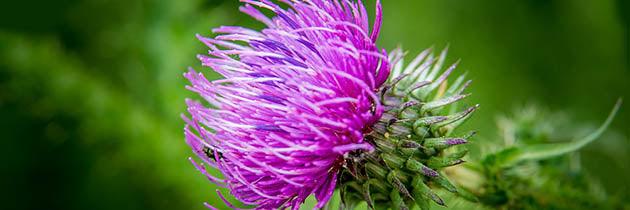QUICK FACTS
Scientific name: Silybum marianum
Other names: Mary’s thistle, St. Mary’s thistle, lady’s holy thistle, holy thistle, Venus thistle, Mediterranean thistle, blessed milk thistle
Location: Native to southern Europe and North Africa
Known for: Potent liver support and bright purple flowers
Part Used: Seeds most commonly, but all plant parts may be used if prepared correctly
Fun fact: In some traditions, it is said that the milk of the Virgin Mary once fell upon a thistle plant bestowing it with its milky white leaf veins, hence the Latin species name: marianum.
Good for: Liver support and protection, healthy bile flow, improved digestion, kidney support
Key Properties & Actions: Hepatodetoxifier, hepatoprotective, hepatoregenerative, antifibrotic, anti-inflammatory, antioxidant, cholagogue (stimulates bile flow), kidney protective
What is Milk Thistle?
Silybum marianum, commonly called milk thistle, is a biennial plant native to the Mediterranean regions of southern Europe and North Africa. In true biennial fashion milk thistle produces a showy base of spiky leaves marbled with milky white lines in its first year. In its second year, a 3- to 5-foot stalk emerges, crowned by a purple flowerhead. When cut, the prickly leaves and stem produce a milky sap, hence the name milk thistle.

Milk thistle is commonly found growing in pastures, large fields, disturbed soils, and along roadsides. Although it may be considered a weed by some, by many, it is regarded as one of the best hepatoprotective (liver-protective) herbs. For thousands of years, milk thistle has been called upon to support the liver, and today, it is the most widely researched hepatoprotective herb.
Beyond its ability to support and protect the liver, milk thistle encourages healthy antioxidant levels in liver cells, promotes bile flow, aids digestion, protects the kidneys, and provides anti-inflammatory support.
Benefits of Milk Thistle and How It Works
Liver Support and Protection
Although many herbs can support and protect liver function, milk thistle is one of the best. In today’s modern world, it is easy for the liver to become overburdened.
Internal and external factors such as excessive alcohol and drug consumption, environmental toxins, viruses, and an unhealthy diet can all lead to a stressed and eventually damaged liver. Milk thistle has been shown to protect against this type of damage in a variety of ways.
Milk thistle’s liver-supportive benefits are attributed to its anti-inflammatory and antioxidant actions, as well as its ability to improve mitochondrial function and stimulate protein synthesis necessary for liver regeneration.1,2,3 In a double-blind clinical trial, a milk thistle extract and vitamin E complex improved liver enzyme levels and reduced liver fibrosis in non-alcoholic fatty liver disease patients.4
A 2014 animal study showed milk thistle extract was able to reduce oxidative stress due to alcohol consumption.5
Healthy Antioxidant Levels
Silymarin, a group of beneficial flavonoids found in milk thistle, are potent antioxidants that can neutralize harmful free radicals that result from normal metabolic processes and the breakdown of toxic substances.6
Milk thistle can also increase the levels of natural antioxidants found in liver cells like glutathione.6
Promotes Bile Flow and Digestion
Milk thistle is able to promote bile flow from the liver and gallbladder. This increased movement of bile can enhance digestion since bile is necessary for the proper breakdown of fats. It can also be helpful in sluggish gallbladder conditions like cholestasis, where there is a decrease in bile flow and bile duct inflammation.7
In a 2015 study, silymarin was found to promote healing and maintain remission in patients with ulcerative colitis, an inflammatory bowel disease. The authors of this study suggest that the beneficial effects of silymarin in ulcerative colitis are due to its antioxidant properties. Additionally, prior animal studies have shown that silymarin can reduce inflammatory cytokines in the bowel.8
Protects Kidneys
Recent evidence shows that milk thistle is as important for kidney health as it is for liver health. Silymarin can aid in the repairing and regenerating of kidney cells by increasing protein and nucleic acid synthesis.6
Various studies have shown milk thistle’s benefit in protecting against kidney deterioration related to diabetes.6,9
Anti-inflammatory
Milk thistle has anti-inflammatory properties that are of benefit to various systems of the body. Much of this anti-inflammatory effect is due to compounds within the plant that can modulate cell-signaling pathways.1,3,10
History & Traditional Use
Milk thistle has a long and varied history of use across many different cultures and traditions. It is said that the first recording of milk thistle as a medicinal plant was made in the Old Testament, where it was referred to as its former Latin name, Lebanon cardus.1,10
In ancient Greece, the Greek physician Dioscorides employed milk thistle for snake bites. Around the same time, milk thistle was used for depression which was attributed to an impaired liver.1
More recently, milk thistle was an important plant used by the American Eclectic physicians of the late 19th and early 20th centuries. These physicians utilized non-invasive and botanical therapies and administered milk thistle, in particular, for liver and spleen swelling, pelvic congestion, varicose veins, and hemorrhoids.7,12,13

How to Use and Dosing
Milk thistle is best taken as a standardized powdered extract, although it can also be taken in tincture form.
A powdered extract should be standardized to at least 70% silymarin, which is likely the most therapeutic phytochemical present in milk thistle. General dosing recommendations are 200-300 mg, one to three times daily.
When taking a tincture, 2-3 mL, two to three times daily is suggested.
Although a tea does not provide the same liver-supportive benefits as a powder or tincture, it is sometimes used to improve digestion.
In addition to its medicinal uses, milk thistle can also be used in a culinary setting. The whole seeds can be powdered and sprinkled onto food or added into smoothies or juice. A teaspoon to a tablespoon is best.
For added liver support, milk thistle combines well with turmeric, dandelion root, schisandra, reishi mushroom, and andrographis.
Interactions
There are no known interactions.
Always check with your health care practitioner before use if you are taking medications. For more general education on potential interactions between herbs and medications, check out Dr. Bill Rawls’ article: Is it Safe to Take Herbs with My Medications?
Precautions & Side effects
Milk thistle is extremely well tolerated. Adverse reactions are rare, but it could cause loose stools at very high doses.
Disclaimer: This information is intended only as general education and should not be substituted for professional medical advice. Any mentioned general dosage options, safety notices, or possible interactions with prescription drugs are for educational purposes only and must be considered in the context of each individual’s health situation and the quality and potency of the product being used. Use this information only as a reference in conjunction with the guidance of a qualified healthcare practitioner.
1. Tsai JH, Liu JY, Wu TT, et al. Effects of silymarin on the resolution of liver fibrosis induced by carbon tetrachloride in rats. J Viral Hepat. 2008;15(7):508-514. doi:10.1111/j.1365-2893.2008.00971.x
2. Wei F, Liu SK, Liu XY, et al. Meta-analysis: silymarin and its combination therapy for the treatment of chronic hepatitis B. Eur J Clin Microbiol Infect Dis. 2013;32(5):657-669. doi:10.1007/s10096-012-1789-1
3. Hackett ES, Twedt DC, Gustafson DL. Milk thistle and its derivative compounds: a review of opportunities for treatment of liver disease. J Vet Intern Med. 2013;27(1):10-16. doi:10.1111/jvim.12002
4. Loguercio C, Andreone P, Brisc C, et al. Silybin combined with phosphatidylcholine and vitamin E in patients with nonalcoholic fatty liver disease: a randomized controlled trial. Free Radic Biol Med. 2012;52(9):1658-1665. doi:10.1016/j.freeradbiomed.2012.02.008
5. Song Z, Deaciuc I, Song M, et al. Silymarin protects against acute ethanol-induced hepatotoxicity in mice. Alcohol Clin Exp Res. 2006;30(3):407-413. doi:10.1111/j.1530-0277.2006.00063.
6. Rafieian-Kopaie M, Nasri H. Silymarin and diabetic nephropathy. J Renal Inj Prev. 2012;1(1):3-5. Published 2012 Jan 1. doi:10.12861/jrip.2012.0
7. Christa S. In: The Essential Guide to Western Botanical Medicine. Arcata, CA: Christa Sinadinos; 2020:331-334.
8. Rastegarpanah M, Malekzadeh R, Vahedi H, et al. A randomized, double blinded, placebo-controlled clinical trial of silymarin in ulcerative colitis. Chin J Integr Med. 2015;21(12):902-906. doi:10.1007/s11655-012-1026-x
9. Amiri M, Motamedi P, Vakili L, et al. Beyond the liver protective efficacy of silymarin; bright renoprotective effect on diabetic kidney disease. J Nephropharmacol. 2014;3(2):25-26. Published 2014 Jul 1
10. Bijak M. Silybin, a Major Bioactive Component of Milk Thistle (Silybum marianum L. Gaernt.)-Chemistry, Bioavailability, and Metabolism. Molecules. 2017;22(11):1942. Published 2017 Nov 10. doi:10.3390/molecules22111942
11. Bijak M. Silybin, a Major Bioactive Component of Milk Thistle (Silybum marianum L. Gaernt.)-Chemistry, Bioavailability, and Metabolism. Molecules. 2017;22(11):1942. Published 2017 Nov 10. doi:10.3390/molecules22111942
12. Carduus Marianus.—St. Mary’s Thistle. Henriettes-herb.com. https://www.henriettes-herb.com/eclectic/kings/silybum.html. Accessed June 14, 2022.
13. Milk Thistle. Henriettes-herb.com. https://www.henriettes-herb.com/eclectic/hill/thistle-milk.html. Accessed June 14, 2022.




